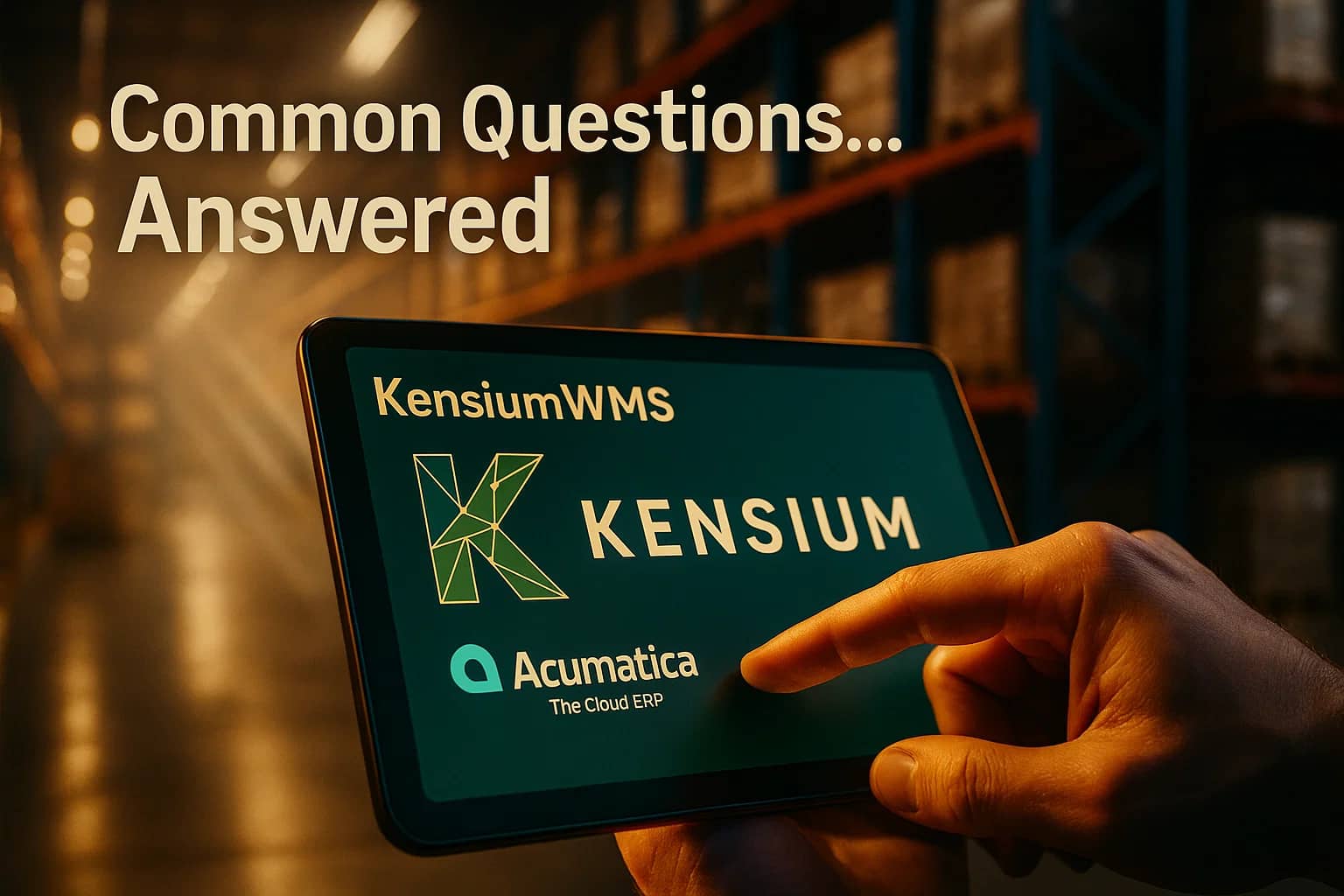
Why Embedded Warehouse Management Matters More Than Ever
E-commerce and omni-channel fulfillment have reshaped warehouse operations. Global online retail is growing nearly 8% year-over-year according to Reuters, and that surge has exposed the limits of “good enough” warehouse tools.
While Acumatica Cloud ERP includes a native Warehouse Management System (WMS), many businesses discover gaps as they scale — slower fulfillment, manual workarounds, and difficulty managing complex picking or palletization.
Kensium’s Warehouse Management Solution was built to bridge that gap. It’s not an integration or overlay. It’s a fully embedded WMS inside Acumatica, sharing the same database, interface, and logic — the only solution of its kind. The result: seamless real-time data, zero sync errors, and simplified upgrades.
1. Fully Embedded — Not Just Connected
Most third-party WMS tools sit outside your ERP, requiring connectors, external databases, and periodic sync jobs. Kensium WMS doesn’t.
It runs directly on Acumatica’s ERP platform, using the same user interface and security framework. Every scan, receipt, or shipment instantly updates Acumatica’s core tables — no duplication, no middleware, no lag.
This embedded architecture gives warehouse teams what every operations leader wants:
- Real-time accuracy: The moment a worker scans an item, inventory updates system-wide.
- Single source of truth: Orders, stock, and fulfillment data all live in one system.
- Low maintenance: Acumatica upgrades are mirrored by Kensium’s WMS updates, requiring only a few hours to publish and test.
Because Kensium acquired FusionWMS and rebuilt it into Acumatica’s framework, it remains the only complete WMS natively embedded within Acumatica — not a bolt-on, but an extension of the ERP itself.
2. Beyond Basic WMS — Advanced Capabilities for Modern Warehouses
Acumatica’s standard WMS handles essentials: receiving, transfers, picking, and packing. Kensium extends that foundation into an enterprise-grade fulfillment engine.
Key Differentiators
- Multi-Level Packaging: Build cartons, pallets, and containers with complete “license plating” — assigning a single ID to every bundle for faster tracking and movement.
- Advanced Picking: Supports wave, batch, and zone picking methods to reduce travel time and prioritize urgent orders.
- Cross-Docking: Move inbound goods directly to outbound staging to speed order turnaround.
- Smart Bin Management: Configure primary and bulk bins with automatic replenishment triggers.
- Suggested Put-Away: Guide warehouse staff to optimal bin locations using rule-based logic.
Each feature was designed to reduce touches and errors. One distributor using Kensium WMS reported a 30% reduction in picking labor after deploying wave and zone picking, while maintaining same-day shipping SLA.
3. Real-Time Visibility Inside Acumatica
Unlike external systems that sync periodically, Kensium WMS gives live dashboards within Acumatica itself — showing pick progress, order status, and location-specific inventory movement in real time.
Supervisors can instantly view:
- Open picks and pending replenishments
- Pallet-level stock visibility
- Item activity by lot, serial, or expiration date
- Operator performance metrics
Because it’s part of Acumatica, managers don’t need a separate login or interface — just open the WMS workspace and see everything that’s happening across every warehouse.
4. Hardware Compatibility and Mobility
Kensium WMS runs as a native Android app, optimized for rugged warehouse devices.
It supports Android 14 or higher on scanners and tablets from Zebra, Honeywell, and Motorola, ensuring long-term OS support and durability.
Recommended Devices
- Zebra TC series or Honeywell CK/EDA scanners for daily use.
- Bluetooth ring scanners or tablets for lighter environments.
- Zebra GK / ZT thermal printers for label and barcode printing.
The mobile interface mirrors Acumatica workflows — so warehouse operators don’t need to learn a new system.
Label printing is integrated directly into the WMS app, allowing teams to print item, bin, or pallet labels without switching devices.
5. Barcode, Label, and RFID Capabilities
Kensium’s Advanced Label Printing module supports standard 1D/2D barcodes and GS1-128/UCC-128 compliance labeling.
When scanning supplier-provided GS1 barcodes that encode multiple data fields (SKU, lot, quantity, expiration date), the WMS automatically parses that information into the correct Acumatica fields — saving time and ensuring data accuracy.
For official GS1 or retailer-compliant shipping labels, the WMS connects to EDI or label management tools that generate those labels automatically using real-time WMS data.
RFID-readiness:
While Acumatica doesn’t include built-in RFID portal management, Kensium WMS can integrate with RFID-enabled handhelds (Zebra RFD8500, Honeywell IH series) or connect to RFID gateways via Acumatica’s open API. These configurations enable real-time item tracking and automated dock-door reads for advanced operations.
6. Integrations with E-Commerce and Automation
As Acumatica’s official Commerce ISV Partner, Kensium provides native connectors for:
- Shopify
- BigCommerce
- Adobe Commerce (Magento)
These integrations allow orders from online stores to flow directly into Acumatica, where Kensium WMS automatically drives picking, packing, and shipment confirmation.
A manufacturer using Acumatica + BigCommerce via Kensium’s integration achieved same-day order turnaround because “inventory, orders, and shipments were always in sync” — no manual imports, no data drift.
Warehouse Automation
Kensium WMS also connects to material-handling equipment like Vertical Lift Modules (VLMs) or conveyor systems through Acumatica’s REST APIs. Pick tickets and confirmations pass between the ERP and automation layer in real time, creating a unified automation ecosystem.
According to Reuters, the warehousing sector is moving rapidly toward 60–65% automation in the next few years — Kensium WMS gives you the real-time data infrastructure to support that evolution.
7. Implementation and Upgrades
Adding Kensium WMS to an Acumatica deployment is straightforward.
A typical implementation adds roughly 35–40 consulting hours, covering:
- Sandbox installation and testing
- Configuration of bins, picking strategies, and label formats
- User training and handheld setup
- Promotion to production
Because it’s embedded, there’s no integration project — only setup and training.
Upgrades are similarly simple: when Acumatica releases its annual R1/R2 version, Kensium publishes a matching WMS update. Applying it involves publishing the new package and running brief validation tests — typically less than a day’s work.
Support is unified under Kensium’s Acumatica practice — one vendor, one helpdesk, one knowledge base.
8. Real Results from Embedded Architecture
Businesses using Kensium WMS inside Acumatica consistently report:
- 50% faster fulfillment due to wave and zone picking
- 95%+ order accuracy with scan validation
- Elimination of sync failures from disconnected systems
- Simplified audits since all transactions (receipts, moves, picks) live in Acumatica
In contrast, third-party WMS tools require integration maintenance, middleware monitoring, and complex version alignment.
Kensium’s embedded model means your ERP and WMS evolve together — no data duplication, no downtime, and no finger-pointing between vendors.
9. Typical Workflow: From Receiving to Shipping
Here’s how Kensium WMS orchestrates a full fulfillment cycle — all within Acumatica:
- Receiving: Scan incoming goods against a Purchase Order or ASN. Capture lots, serials, and quantities instantly.
- Labeling: Print internal pallet or item labels with one tap.
- Put-Away: Use the app’s guided put-away to assign bins or follow system recommendations.
- Allocation: Orders sync from e-commerce or sales into Acumatica; stock is auto-allocated.
- Picking: Workers execute pick waves via handhelds. Scans validate items and bins in real time.
- Packing: Confirm quantities, print shipping labels, and build cartons/pallets.
- Shipping: Confirm shipments within Acumatica. Status updates sync instantly back to e-commerce.
Optional load verification workflows can ensure every pallet scanned is loaded onto the correct truck before dispatch.
This unified process provides full traceability — from receiving to shipping — without ever leaving Acumatica.
10. Maintenance, Support, and Flexibility
Kensium WMS follows Acumatica’s modular philosophy — configurable, not custom-heavy.
Administrators can tailor handheld menus, scan prompts, or workflows per role.
Need a custom field or step? Kensium can extend the WMS via Acumatica’s customization tools without affecting upgrade compatibility.
Support includes:
- 24x7 ticketing through Kensium’s Managed Services
- Proactive WMS update notifications aligned to Acumatica releases
- Access to product documentation and training videos
This means your warehouse teams stay productive while your IT team stays focused on business, not integrations.
Catch Up on Our Recent Webinar: Get More from Your WMS with Kensium
We recently hosted an in-depth session showing how Acumatica users are optimizing receiving, picking, and shipping with Kensium’s fully embedded WMS.
If you missed it live, you can now watch the complete recording and hear our experts discuss how to extend Acumatica’s native capabilities — no bolt-ons, no sync delays, just real-time control.
11. Why Choose Embedded Over Integrated
This architecture difference is more than convenience — it’s risk mitigation. Every second of data latency between ERP and WMS can translate into inventory errors, missed shipments, and unhappy customers. Kensium’s solution eliminates that risk entirely.
Ready to Elevate Your Warehouse Operations?
Whether you’re scaling distribution or expanding e-commerce channels, your warehouse systems must move as fast as your customers.
Kensium WMS for Acumatica gives you full control — embedded, real-time, and built for modern fulfillment.
Frequently Asked Questions
Q: Is Kensium WMS truly embedded or integrated?
A: It’s 100% embedded on Acumatica’s xRP platform. No external databases, APIs, or middleware.
Q: How does it differ from Acumatica’s standard WMS?
A: It includes advanced picking, palletization, cross-docking, license plating, and guided put-away not available in the base module.
Q: Does it support my existing warehouse hardware?
A: Yes — all Android-based handhelds and printers compatible with Acumatica work with Kensium WMS.
Q: Can it handle RFID or automation systems?
A: RFID handhelds and automated material-handling equipment integrate through Acumatica’s API layer.
Q: What’s the implementation effort?
A: Typically 35–40 hours for full setup, testing, and training — faster for existing Acumatica users.








.png)



.jpg)

